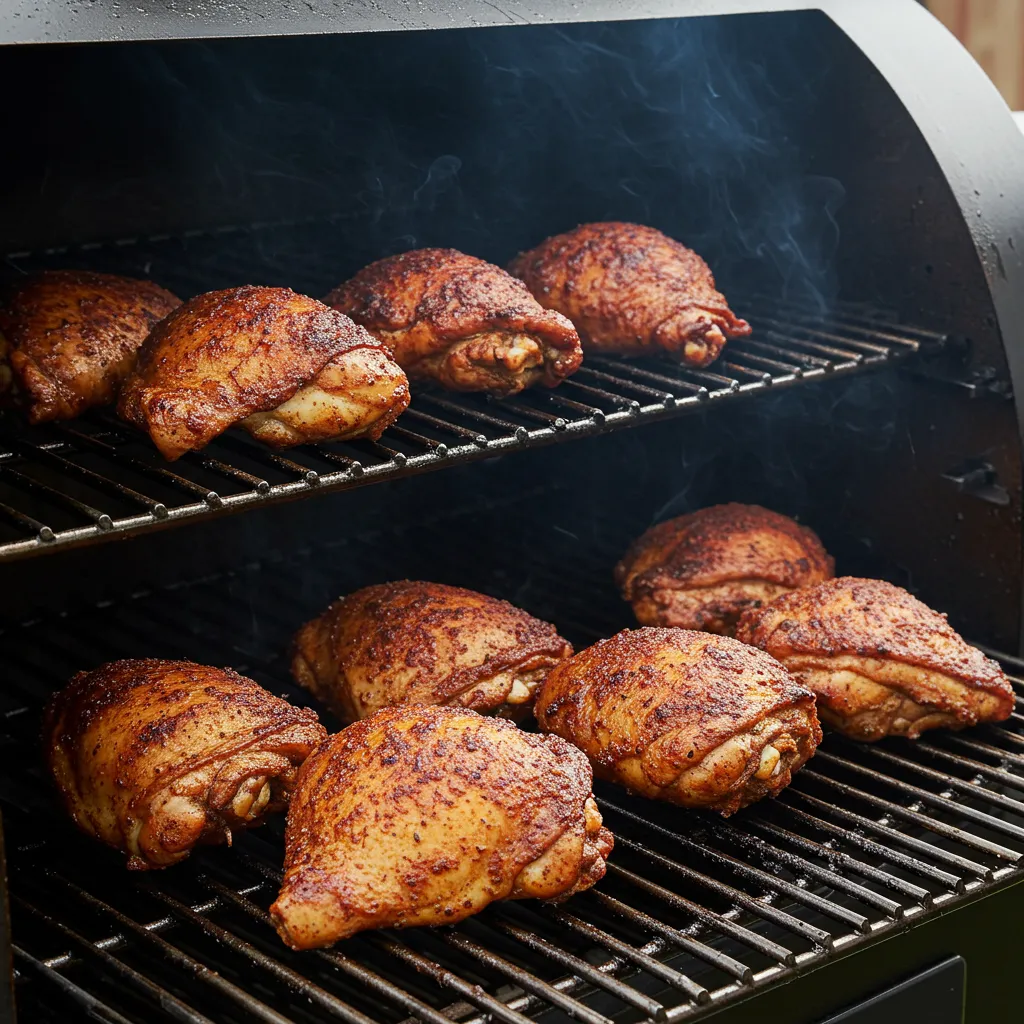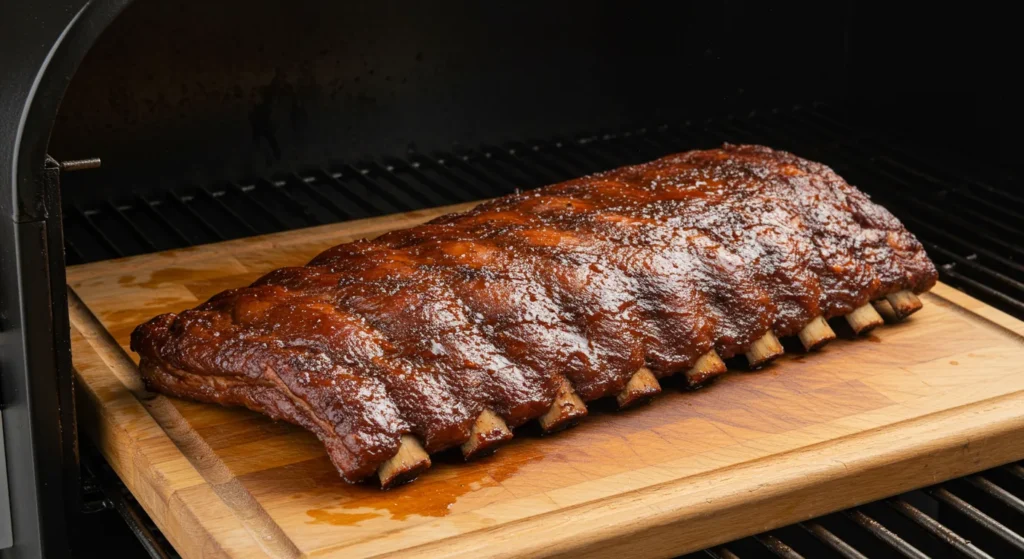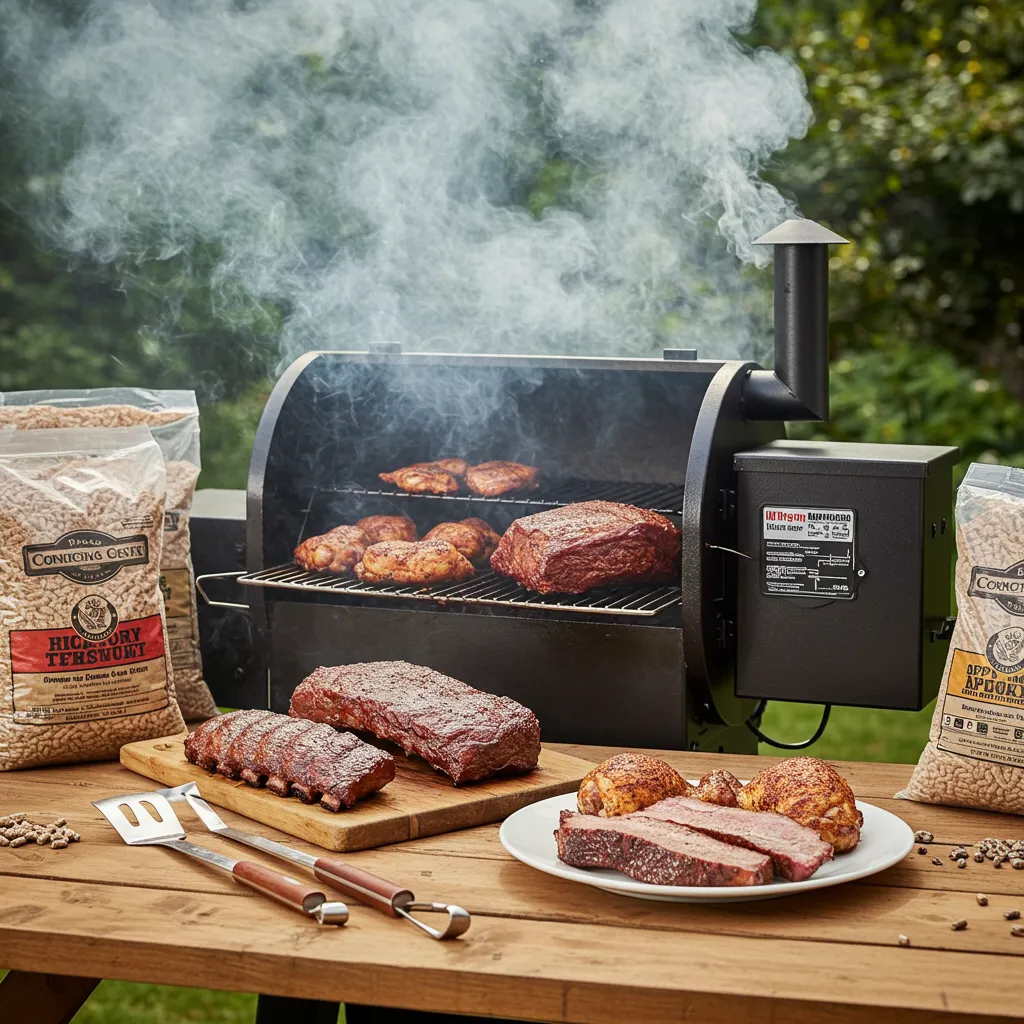Introduction
If you love BBQ (Barbecue), mastering pellet smoker recipes is a game-changer! A pellet smoker offers the perfect balance of convenience and authentic smoky flavor, making it ideal for beginners and seasoned grillers alike. Whether you’re craving juicy smoked ribs, tender brisket, or flavorful chicken, this guide will walk you through the best easy and delicious pellet smoker recipes to try at home.
In this article, you’ll discover step-by-step instructions, the best wood pellet flavors, and expert tips to enhance your smoking skills. Get ready to fire up your pellet grill and create mouthwatering BBQ dishes with ease! 🔥🍖
Getting Started with Pellet Smoker Recipes
Before diving into delicious pellet smoker recipes, it’s essential to understand the basics. Choosing the right pellet smoker, selecting the best wood pellets, and mastering key smoking techniques will set you up for BBQ success. Whether you’re a beginner or an experienced pitmaster, these tips will help you create flavorful, tender smoked meats every time.
How to Choose the Right Pellet Smoker
Not all pellet smokers are created equal. Choosing the right one depends on your budget, cooking style, and desired features. Two of the most popular brands in the U.S. are Traeger and Pit Boss. Both offer high-quality smokers, but they have some key differences.
- Traeger Pellet Smokers – Known for their consistent temperature control, Wi-Fi connectivity, and durable build. They are a premium option with a reputation for reliability.
- Pit Boss Pellet Smokers – More budget-friendly while still offering great temperature control and larger cooking space. Some models allow direct flame grilling, which adds versatility.
When choosing a pellet smoker, consider these features:
- ✔ Temperature Control – Digital controls help maintain precise smoking temperatures.
- ✔ Pellet Hopper Capacity – A larger hopper means longer smoking sessions without refilling.
- ✔ Cooking Space – Choose a size based on how many people you typically cook for.
A well-chosen pellet smoker makes smoking ribs, brisket, and chicken easier and more enjoyable.
Best Wood Pellets for Smoking Meat
The type of wood pellets you use significantly affects the flavor of your food. Different woods pair well with different meats, enhancing their taste without overpowering them.
- Hickory – Strong, smoky, and slightly sweet. Best for brisket, ribs, and pork.
- Mesquite – Bold, earthy, and intense. Ideal for beef and wild game.
- Applewood – Mild, fruity, and slightly sweet. Perfect for chicken, pork, and fish.
For the best results, match your wood pellets to your protein:
- ✔ Chicken & Turkey – Applewood or cherry for a mild, slightly sweet taste.
- ✔ Beef & Brisket – Hickory or mesquite for a deep, smoky flavor.
- ✔ Pork & Ribs – A mix of hickory and applewood for a balanced taste.
Experimenting with wood pellet flavors allows you to customize the taste of your pellet smoker recipes.
Essential Smoking Techniques for Perfect BBQ
To achieve the best pellet smoker recipes, you need the right techniques. Two of the most effective methods are low and slow cooking and the reverse sear method.
✔ Low and Slow Cooking – Smoking meat at 225°F – 250°F for several hours creates tender, juicy results. This technique works best for ribs, brisket, and pork shoulder.
✔ Reverse Sear Method – Ideal for steaks and brisket, this method involves smoking the meat at a lower temperature first, then finishing it with a high-heat sear for a flavorful crust.
Mastering these techniques will help you create mouthwatering pellet smoker recipes with rich, smoky flavors.
Best Pellet Smoker Recipes for Beginners
If you’re new to pellet smoker recipes, starting with simple yet flavorful dishes is the best way to build confidence. These easy recipes will help you get familiar with smoking techniques while delivering delicious results. Whether you’re making smoked chicken thighs, tender ribs, or juicy brisket, these step-by-step instructions will guide you to BBQ success.
Easy Smoked Chicken Thighs Recipe

Smoking chicken thighs is one of the easiest ways to get started with a pellet smoker. The dark meat stays juicy, and the crispy skin absorbs the perfect amount of smoke.
Ingredients
- 4 bone-in, skin-on chicken thighs
- 2 tbsp olive oil
- 1 tbsp smoked paprika
- 1 tbsp garlic powder
- 1 tsp salt
- 1 tsp black pepper
- 1 tsp onion powder
- 1 cup hickory wood pellets
Instructions
- Preheat your pellet smoker to 225°F. Use hickory pellets for a bold, smoky flavor.
- Prepare the chicken thighs by patting them dry and coating them with olive oil.
- Mix the dry rub ingredients and evenly coat the chicken.
- Place the chicken on the smoker and cook for 1.5 to 2 hours, until the internal temperature reaches 165°F.
- Increase the temperature to 375°F for the last 10 minutes to crisp up the skin.
- Remove and rest for 5 minutes before serving.
This pellet smoker recipe delivers juicy, flavorful chicken with a perfect smoky finish.
Smoked Ribs on a Pellet Grill (3-2-1 Method)

The 3-2-1 method is the best way to get tender, fall-off-the-bone ribs. It involves three stages: smoking, wrapping, and saucing.
Ingredients
- 1 rack of baby back ribs
- ¼ cup yellow mustard (for binding)
- ¼ cup brown sugar
- 2 tbsp BBQ rub
- ½ cup apple juice
- ½ cup BBQ sauce
- Wood pellets: Applewood for a sweet, mild smoke
Instructions
- Preheat your pellet smoker to 225°F with applewood pellets.
- Remove the membrane from the ribs and rub them with mustard.
- Apply the BBQ rub evenly on all sides.
- Smoke for 3 hours uncovered.
- Wrap in foil with brown sugar and apple juice, then smoke for 2 more hours.
- Unwrap, brush with BBQ sauce, and smoke for 1 more hour.
- Let the ribs rest for 10 minutes before serving.
The applewood pellets enhance the ribs with a sweet, smoky flavor that pairs perfectly with BBQ sauce.
Classic Smoked Brisket Recipe
Brisket is the king of pellet smoker recipes, but it requires patience and technique. The secret to a perfect brisket is low and slow smoking with the right wood pellets.
Ingredients
- 1 whole packer brisket (10-12 lbs)
- ¼ cup kosher salt
- ¼ cup black pepper
- 1 tbsp garlic powder
- Wood pellets: Hickory or mesquite for deep smoke flavor
Instructions
- Trim the brisket, removing excess fat while leaving about ¼ inch of the fat cap.
- Season generously with salt, pepper, and garlic powder.
- Preheat your pellet smoker to 225°F with hickory or mesquite pellets.
- Smoke the brisket fat-side up for 6-8 hours, until it reaches 165°F internal temperature.
- Wrap tightly in butcher paper and continue smoking until it reaches 200-205°F (about 4-6 more hours).
- Let it rest for at least 1 hour before slicing.
To get the perfect smoke ring, maintain a steady low temperature and allow the brisket to absorb smoke in the first few hours.
These beginner-friendly pellet smoker recipes will help you master the basics while delivering delicious BBQ. Once you perfect these, you can start experimenting with different flavors and techniques to take your BBQ game to the next level! 🔥🍖
Advanced Pellet Smoker Recipes for BBQ Lovers
If you’ve mastered the basics, it’s time to take your BBQ skills to the next level with advanced pellet smoker recipes. These dishes require a bit more technique but deliver incredible smoky flavors that will impress any BBQ lover. Whether you’re making smoked pulled pork, maple-glazed salmon, or a holiday turkey, these recipes will elevate your pellet smoking game.
Smoked Pulled Pork with Applewood
Tender, juicy pulled pork is a BBQ favorite. Smoking it low and slow with applewood pellets gives it a slightly sweet, smoky flavor that pairs perfectly with tangy BBQ sauce.
Ingredients
- 1 pork shoulder (8-10 lbs)
- ¼ cup yellow mustard (as a binder)
- ½ cup BBQ rub (paprika, brown sugar, salt, pepper, garlic powder)
- ½ cup apple juice (for spritzing)
- Wood pellets: Applewood for mild, fruity smoke
Instructions
- Preheat your pellet smoker to 225°F with applewood pellets.
- Trim excess fat from the pork shoulder and coat it with mustard.
- Apply the BBQ rub generously, covering all sides.
- Smoke for 4-5 hours, spritzing with apple juice every hour.
- Once the internal temp reaches 165°F, wrap tightly in foil and continue smoking.
- When it reaches 203°F, remove from the smoker and let it rest for at least 1 hour.
- Shred the pork using forks or meat claws, mix with BBQ sauce, and serve.
This pulled pork recipe delivers fall-apart tenderness with a rich smoky flavor that’s perfect for sandwiches or tacos.
Smoked Salmon with a Maple Glaze
Smoking salmon on a pellet grill creates a delicious balance of smoky and sweet flavors. A maple glaze enhances the natural richness of the fish while keeping it moist and flaky.
Ingredients
- 2 lbs salmon fillet (skin-on)
- ¼ cup maple syrup
- 2 tbsp soy sauce
- 1 tbsp Dijon mustard
- 1 tsp garlic powder
- ½ tsp black pepper
- Wood pellets: Cherry or alder for a mild, sweet smoke
Instructions
- Preheat your pellet smoker to 225°F with cherry or alder pellets.
- Mix the maple glaze ingredients and brush generously over the salmon.
- Place the salmon skin-side down on a greased grill grate.
- Smoke for 1-2 hours, until the internal temperature reaches 145°F.
- Brush with extra glaze in the last 15 minutes for a richer flavor.
- Let it rest for 5 minutes, then serve with fresh herbs or lemon wedges.
To keep the salmon moist, avoid overcooking and use a water pan in the smoker to maintain humidity.
Ultimate Smoked Turkey for the Holidays
A smoked turkey is a show-stopping dish for any holiday feast. Using a pellet smoker infuses the meat with rich, smoky flavor while keeping it juicy.
Brining vs. Dry Rub
- Brining (soaking the turkey in saltwater overnight) helps retain moisture.
- Dry rub (applying seasoning directly to the skin) creates a crispy, flavorful crust.
Ingredients
- 1 whole turkey (12-14 lbs)
- ½ cup butter (melted)
- ¼ cup kosher salt
- 1 tbsp black pepper
- 1 tbsp garlic powder
- 1 tbsp smoked paprika
- Wood pellets: Hickory or pecan for a rich, smoky taste
Instructions
- Preheat your pellet smoker to 275°F with hickory or pecan pellets.
- Pat the turkey dry and coat with melted butter.
- Season generously with the dry rub.
- Smoke for 3-4 hours, basting with butter every hour.
- Once the internal temperature reaches 165°F in the thickest part of the breast, remove and let it rest for 20-30 minutes.
Smoking at 275°F ensures a juicy, evenly cooked turkey with crispy skin.
These advanced pellet smoker recipes will help you achieve next-level BBQ flavor with perfectly smoked meats and seafood. Try them at your next cookout or holiday gathering, and enjoy restaurant-quality smoked dishes at home! 🔥🍖
Pro Tips for Perfect Pellet Smoker Cooking
Mastering a pellet smoker goes beyond just following recipes—it’s about understanding the best techniques, proper maintenance, and avoiding common mistakes. These pro tips will help you achieve the best BBQ results, ensuring perfect temperature control, clean smoke, and rich flavors every time you cook.
Best Meat Temperature Guide for Smoking
Cooking meat to the right internal temperature is essential for both safety and flavor. Overcooked meat becomes dry, while undercooked meat can be unsafe to eat. A meat thermometer is the best tool for accuracy when using a pellet smoker.
Safe Internal Temperatures:
- Chicken (Thighs & Breasts): 165°F
- Pork (Ribs, Pulled Pork, Chops): 145°F (ribs should go up to 190-203°F for tenderness)
- Beef (Brisket, Steak, Burgers):
- Brisket: 200-205°F
- Medium Steak: 135°F
- Well-Done Steak: 160°F
- Fish (Salmon, Trout, Tuna): 145°F
Tips for Accurate Temperature Control:
- Use a digital meat thermometer to check doneness without guessing.
- Monitor smoker temperature regularly to ensure even cooking.
- Wrap meat (like brisket and ribs) in foil or butcher paper once it reaches 165°F to retain moisture.
Keeping your meat at the correct internal temperature ensures juicy, tender results every time you smoke.
How to Maintain and Clean Your Pellet Smoker
Regular maintenance is key to keeping your pellet smoker working efficiently. A clean smoker produces better smoke, prevents flare-ups, and extends the life of your grill.
Cleaning Tips for Pellet Smokers (Traeger, Pit Boss, etc.):
- Empty the grease trap after every cook to avoid buildup.
- Vacuum out ash from the firepot every 3-4 uses.
- Wipe down the grill grates with a grill brush after each session.
- Deep clean every few months by scrubbing the interior with warm, soapy water.
How to Prevent Temperature Fluctuations:
- Use high-quality wood pellets (avoid cheap brands that create excess ash).
- Keep the lid closed as much as possible to maintain steady heat.
- Check the pellet hopper regularly to prevent running out mid-cook.
A well-maintained pellet smoker ensures consistent performance and delicious BBQ every time.
Common Pellet Smoker Mistakes to Avoid
Even experienced grill masters can make mistakes that affect the flavor and texture of their BBQ. Avoid these common pellet smoker pitfalls to get the best results.
1. Over-Smoking the Meat
- Too much smoke can make the meat bitter.
- Use mild wood pellets (like applewood or cherry) for delicate meats like chicken and fish.
- Keep smoke exposure low for the first 3-4 hours of cooking for larger cuts like brisket.
2. Fluctuating Temperatures
- Avoid opening the lid frequently—this lets heat escape and slows down cooking.
- Check the weather—cold or windy conditions can affect your smoker’s performance.
- Invest in a temperature controller for more precise heat regulation.
3. Choosing the Wrong Wood Pellet Flavors
- Strong woods (hickory, mesquite) can overpower chicken or seafood.
- Sweet woods (apple, cherry, pecan) pair best with pork and poultry.
- Experiment with mixing flavors for unique smoke profiles.
By avoiding these mistakes, you’ll improve your BBQ results and create better-tasting smoked meats every time.
Final Thoughts on Pellet Smoker Recipes
Using a pellet smoker is one of the easiest ways to achieve flavorful, tender, and perfectly smoked meats. Throughout this guide, we’ve explored a variety of pellet smoker recipes, from simple beginner-friendly options to advanced BBQ techniques. Whether you’re smoking chicken thighs, ribs, brisket, pulled pork, salmon, or even a holiday turkey, the right method and ingredients make all the difference.
Recap of the Best Pellet Smoker Recipes
For beginners, recipes like easy smoked chicken thighs and 3-2-1 smoked ribs provide a great introduction to using a pellet smoker. These dishes highlight essential techniques like dry rubs, temperature control, and selecting the best wood pellets.
For those ready to take their skills to the next level, smoked brisket, pulled pork, and smoked salmon offer deeper flavor complexity. These recipes require low-and-slow cooking, proper seasoning, and monitoring smoke levels to achieve the best results. If you’re preparing for a holiday feast, smoked turkey is a showstopping dish that benefits from brining and careful temperature control.
Experiment with Different Wood Pellet Flavors
The type of wood pellets you use can transform the taste of your BBQ. Hickory and mesquite add bold, smoky flavors perfect for brisket and ribs, while applewood and cherry provide a milder, slightly sweet touch for chicken and pork. Pecan and maple work beautifully for salmon and turkey, creating a balanced and rich taste.
Don’t be afraid to mix wood pellet flavors to create unique combinations. Blending hickory with cherry can add depth to pork, while a mix of applewood and pecan enhances poultry.
Share Your Favorite Pellet Smoker Recipes
Now, we’d love to hear from you! What’s your go-to pellet smoker recipe? Share your top dishes, wood pellet preferences, and smoking tips in the comments below. Let’s keep the BBQ conversation going and inspire others to create delicious smoked meals at home. 🔥🍖
Conclusion
Mastering pellet smoker recipes is a rewarding journey that brings out the best in BBQ cooking. Whether you’re a beginner experimenting with smoked chicken thighs and ribs or an experienced pitmaster perfecting brisket, pulled pork, and smoked salmon, the key to success lies in temperature control, the right wood pellets, and proper smoking techniques.
The versatility of a pellet smoker allows you to explore different flavors by mixing hickory, mesquite, applewood, cherry, and pecan pellets. Each wood type enhances meats in unique ways, helping you craft rich, smoky flavors that make every bite unforgettable.
Now it’s your turn! What are your favorite pellet smoker recipes? Share your experiences, go-to wood pellet flavors, and best BBQ tips in the comments below. Let’s continue the conversation and make every cookout a flavorful success! 🔥🍖

